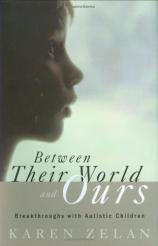Between Their World and Ours: Breakthroughs With Autistic Children
Review
Between Their World and Ours: Breakthroughs With Autistic Children
The word "autism" is most closely associated in the minds of many
people with Dustin Hoffman's portrayal of Raymond in the film,
Rain Man. While the movie, and the portrayal, did much to
raise the level of public awareness of this disorder, what was lost
on most of the audience was the observation of the small-town
physician approximately halfway through the film that Raymond was,
in his words, "high-functioning." As with most conditions, autism
exists across a wide range of severity and impacts the individual
in different ways.
The reader encountering Karen Zelan's BETWEEN THEIR WORLD AND OURS
is best served by being at least marginally acquainted with what
autism is. Zelan assumes the reader is familiar with the subject
matter. This is not a criticism; Zelan does not pretend that her
work is a textbook for Autism 101. If it appears to be aimed at any
audience, it would be the parents of young children who are
themselves dealing with the condition afflicting their child, and
assisting that child in dealing with it.
The book begins with an overview, followed by a summary of the
cases of a number of children whom Zelan has encountered and/or
treated over the years who have been classified as autistic. She
then discusses various topics of interest in assisting the autistic
child --- socialization, problem solving, self-awareness and
friendship, among others --- and devotes some time to an account of
a school that provides special focus on assisting young autists.
The final chapters in BETWEEN THEIR WORLD AND OURS provide Zelan's
suggestions on what to do with, and for, childhood autists and what
hope lies on the horizon for the understanding and treatment of the
condition.
Zelan is both an assister and an advocate for autists and, as is
often the case with such individuals, may go a bit overboard. Her
statement near the end of her work that "(A)utism, as lived out, is
not so much a disease as it is a social condition" is certainly one
with which reasonable and educated minds could differ. There are
also those who may take issue with some of the accommodating
classroom methods that she finds so wonderful; there are legitimate
questions as to whether these are more harmful than helpful. The
world makes demands; a program that prods, however gently, the
autist to adapt to the world would appear to be more beneficial to
the autist than having the autist's world adapt to him or her.
That, ultimately, is not going to happen. Indeed, Zelan appears to
tacitly acknowledge this in her "What To Do" chapter, a short but
informative guide to the parents of autists as to how to assist
their child in the home environment. However, the major benefit of
BETWEEN THEIR WORLD AND OURS is the repeated message to parents
that autism is a neurological condition, not the result of a trauma
or parenting deficiency.
Zelan has studied and worked with young autists for over 40 years,
and the individuals whose cases are discussed in BETWEEN THEIR
WORLD AND OURS have, apparently, all attained their majority. A
companion volume to this one, discussing what ultimately happened
to these children, particularly the ones encountered in the
classroom setting, would be even more interesting, and most
welcome.
Reviewed by Joe Hartlaub on January 21, 2011
Between Their World and Ours: Breakthroughs With Autistic Children
- Publication Date: May 22, 2003
- Hardcover: 320 pages
- Publisher: St. Martin's Press
- ISBN-10: 0312313756
- ISBN-13: 9780312313753




